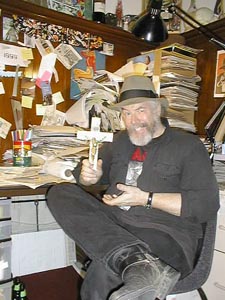![[Metroactive News&Issues]](http://metroactive.com/gifs/news468.gif)
[ San Jose | Metroactive Central | Archives ]
Artist Winston Smith celebrates the last gasp of the 20th century with a Year 2000 calendar
By Jim Rendon
IF THE WORLD bursts into chaos at the stroke of midnight on Jan. 1, 2000, Winston Smith will hardly be surprised. Smith may not even notice the difference.
The 47-year-old collage artist can't help but see the world as a mess--a theater of hypocrisy performed against a backdrop of chaotic brawling. For the last 25 years, Smith has brought that vision to life with simple childlike tools: a utility knife and an UHU glue stick. Now, he's collected 12 of those collages in hopes of milking a little cash from the waning days of the Y2K marketing glut. Smith is entering the gladiator pit with his "I survived the 20th Century Year 2000 Calendar."
It's a cash-in that suits Smith perfectly.
Flipping through a copy of the calendar in his San Francisco home and studio, Smith's blue eyes funnel to a beam of intensity as he turns to an image of monkeys and baboons laughing. One stands on a roller-skate, singing into a microphone, another holds a chainsaw over a fallen primate clutching a beer. Overhead, a fresh-scrubbed '50s couple zips by in their flying car. A spaceship hovers over the hill in the distance. "Another Day at the Office," the caption reads.
"Some people say this is extreme, that the world isn't like this," Smith says, gripping the image. "But for some people in other countries, this really is what life is like."
Smith's conversations never get too far before he's talking politics and injustice. A conversation about the optimistic quality of postwar illustration inevitably ends in a laundry list of political deceit ranging from the sinking of the Lusitania to secret Navy testing of biological weapons of war. Smith is quick to point out that he's a progressive, a running-dog lefty, as he calls it. And he's acutely aware of the inequities between American society and the Third World, and between rich and the poor on the street one story below him.
Smith's apocalyptic vision and his finely honed sense of social commentary were a perfect fit for San Francisco's punk movement in the early 1970s. Appalled by the terribly quality of most punk fliers, Smith began making his own posters for imaginary bands. He even listed shows, including the addresses of empty lots. He was amused to find out that people actually showed up.
Smith's best-known image hangs from a nail over his bed. The cross, wrapped in dollar bills, adorned with a golden crucified Jesus, caused an uproar when it appeared on the Dead Kennedys album Idol. It made the band a household name and launched Smith's career.
His cut-and-paste collages helped to spawn an entire genre of punk poster art.
And Smith went on to do countless posters and album covers for the Dead Kennedys and Jello Biafra's solo projects. Just as punk became more acceptable to middle America, Smith's work also has found a broader audience. He's since done collages for Green Day and art for magazines like Playboy, The New Yorker and Metro.
Smith turns out his work from the bedroom of a flat in North Beach. His workplace has the order of a stack of papers dropped from a plane. Fifty-year-old issues of magazines like Popular Mechanics tower over his desk. Grabbing one, Smith points out the cover art. A happy family zips along in their futuristic steam-powered car.
"I could really use one of those in North Beach," he says. "I'd park anywhere I want to."
Smith grew up on images like these in Oklahoma in the 1950s. Living there was like living anywhere else--only 10 years earlier, he says. In his modest home, this cherry-cheeked Boys Life vision of the world was cut and pasted together with the finest of art. His mother, an artist herself, collected books filled with the works of the great masters, Leonardo DaVinci, Michelangelo, Jan van Eyck, Jan Vermeer, painters whose works still make their way into Smith's creations.
Smith is a voracious collector of cheery illustrations. An entire room in his home is devoted solely to storing the pages that capture America's innocent optimism and unflinching faith in technology. But the real lure for him is not so much that the world envisioned in the pages of Popular Mechanics never came to pass; instead, it's that the opposite has crawled up from the sewer and taken root.
"It's ironic," he says, looking at the sleek steam-powered dream. "They thought in the future we would go 185 miles an hour. Instead we go 55 mph--that's not even as fast as we used to go. There are no flying cars, and instead we are living out of dumpsters."
And while he keeps a sense of humor about it, he doesn't expect much better for the next millennium. In an untitled 1983 collage that I found particularly prophetic in my own high school angst years, Smith makes his own prediction. Magazine cut-out letters over a head about to be stomped on by a boot read, "If you want a picture of the future, imagine a boot stomping a human face forever."
[ San Jose | Metroactive Central | Archives ]
Copyright © 1999 Metro Publishing Inc. Metroactive is affiliated with the Boulevards Network.
For more information about the San Jose/Silicon Valley area, visit sanjose.com.
![]()
 Apocalypse Wow
Apocalypse Wow
From the November 18-24, 1999 issue of Metro, Silicon Valley's Weekly Newspaper.